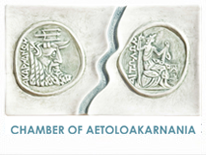ROUTE DESCRIPTIONInside the lagoon there are eight historic islands, most of which refer to the history of the siege of Messolonghi during the Greek Revolution of 1821 where places of heroism emerged. These are: Vasiladi, Tholi, Kleisova, Komma, Marmarou (no longer exists), Plostaina (no longer exists as a fish farm), Prokopanistos and Schinias, before whom they receive respectively the names of the adjacent individual fish farms. The battle of Kleisova The Battle of Kleisova took place on March 25, 1826 and according to experts it should be considered as the most victorious battle in Greek history. The heroic Messolonghi was still resisting. The alliance of Ibrahim and Kioutahi, almost a year and a half since the beginning of the siege of Messolonghi, had not brought the desired results for the Ottomans. Their arrogance was leveled at the heroic walls of Messolonghi. The Greeks still endured. The impasse in which the Ottoman expeditionary force had reached led to the planning of the complete exclusion of the city from land and sea. However, the fortified islands that protected Messolonghi and secured its basic supply by keeping the flame of the resistance alive stood in their plans. The closest was Kleisova, which was the last stronghold of the defenders before Messolonghi, a vigilant guard of freedom at the entrance to the lagoon. An islet with a perimeter of about 300 steps that was defended by 131 men. The battle of Kleisova began in the early morning hours of March 25, 1826, with Kioutachis personally undertaking the raid on the fortress of Kleisova and the certain fall of Messolonghi. Kioutachis attempted six unsuccessful attacks, one after the other. The Turks, however, fell on the targeted and stormy fires of the Greeks that had been fortified on the roof of the church. The trick with the stakes had caught on, as they blocked the amphibious boats and the intruders were forced to walk in shallow water to reach a firing position. In the last attack, Kioutachi himself led the way, in order to inspire his men, but he was hit in the leg and wounded and withdrew from the battle. The departure of the Turkish general caused panic in his army and thus began the erratic flight. It is estimated that more than 1,500 Turks were killed or wounded. Ibrahim, enraged by the terrible losses and the failure of Kioutachis, decided to take the island of Kleisova at all costs and to extinguish any hope of resistance of the heroic battle of Messolonghi. Egyptian ships circled the island and 3,000 spearmen led by his son-in-law, Hussein Bey, stormed the only fortress in the Holy Trinity. "No shots lost" was the order of Chief Kitsos Tzavelas. The "group fire", based on a plan when the enemy would feel very confident that he had come close, succeeded. The first Egyptian line collapsed. The spectacle was so shocking. The second group blast broke up the Turkish-Egyptian front. The shots of the Greeks were so accurate, and the morale of the fighters of Kleisova and Messolonghi was high. Hussein, in a last-ditch effort to get his soldiers alive, got up on the boat. Their shot found him and threw him dead. This was followed by a heroic attack by the Greek guard led by Tzavelas, who, assisted by other Mesolonghi forces from the land, pursued Ibrahim's soldiers into the lagoon and massacred them. by the thousands. The final tally of the siege of Kleisova was estimated at 2,500 to 3,500 casualties. 131 Greek fighters successfully defended an islet 300 meters against two armies with a total strength of 6,000 men. They repulsed eleven consecutive attacks and made history. The magnificent victory, however, was left unexploited and quickly forgotten under the weight of the blood-stained Exodus and the fall of Messolonghi that followed. 131 Greek fighters successfully defended an islet 300 meters against two armies with a total strength of 6,000 men. They repulsed eleven consecutive attacks and made history. The magnificent victory, however, was left unexploited and quickly forgotten under the weight of the blood-stained Exodus and the fall of Messolonghi that followed.
|
|
CULTURE, ENVIROMENT & HISTORY ROUTE in "Messolonghi-Aetoliko" LAGOON












